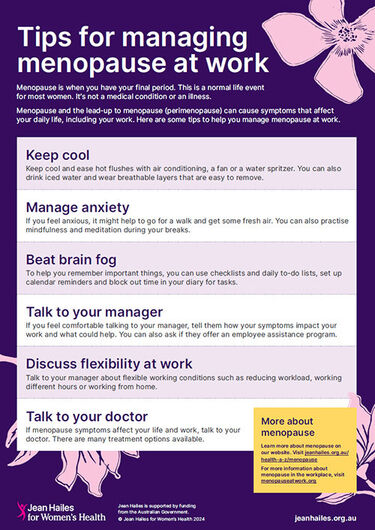As a workplace leader, you may find yourself wanting to better understand menopause and its impacts, so you can offer meaningful support to your team. Navigating this stage in working life is not always straightforward, but your curiosity and willingness to learn can make the world of difference. Taking steps to understand menopause and support your people not only shows empathy but also builds your own confidence as a leader, laying the foundation for a healthier and more inclusive workplace.
For a long time, menopause was rarely discussed, often viewed as a private or even shameful topic. The reasons for this are complex, but the resulting stigma has caused significant harm, contributing to feelings of lost identity and purpose for many.
This sense of shame, combined with the profound hormonal shifts of menopause, can create a stressful environment where experienced, hardworking employees may suffer in silence.
Thankfully, a growing movement is underway to transform how we understand, support, and respond to people approaching this natural life stage.
Let’s explore a scenario
Imagine one of your team members is navigating a huge shift in how they experience their own body and mind. They might not even be aware of what’s really going on, but they just feel ‘off’.
Suddenly, during a meeting, they feel a rush of heat, their heart races, or a bout of confusion hits in the middle of a team session. Their concentration slips, thoughts don’t connect the way they normally do, and anxiety bubbles up, all while trying to maintain their usual high standards. Around them, colleagues might notice the change but don’t understand it either.
For many people, perimenopause and menopause remain topics that are whispered about, misunderstood, or overlooked, both at home and at work. Most menstruating people themselves aren’t fully aware of what to expect, and for leaders and HR professionals, this can make it difficult to navigate.
Why it matters for your organisation
It’s crucial to recognise that, in some cases, employees are experiencing very real cognitive, emotional, and physical changes that affect their work. These changes can affect focus, decision-making, communication, and energy levels, even for highly capable employees who continue to deliver excellent work.
With little awareness and support out there as a whole, it’s important that leaders and HR teams learn to recognise the signs, respond with empathy, and provide flexible support where it’s needed. Especially in situations where everyone might be in the dark.
By understanding what’s happening, you can create an environment where employees feel seen, supported, and able to continue performing at their best. For the organisation, this helps prevent presenteeism, maintain productivity, and retain valuable talent.
"There are only two mammals who have evolved to survive after their childbearing years: toothed whales and humans."
OB/GYN and author of The Menopause Manifesto
Understanding the medical nature of perimenopause, menopause and postmenopause

Key takeaways about menopause
- In simple terms, menopause is the female body’s natural retirement from the reproductive years. It’s officially reached after 12 consecutive months without a menstrual period. In Australia, the average age for this is 51, typically occurring between 45 and 55.
- Menopause happens naturally when the ovaries slow down and stop producing reproductive hormones. This hormonal shift can lead to various physical and emotional effects.
- Perimenopause is the transition phase leading up to menopause and extending for one year after. It is often marked by fluctuating hormones, irregular menstrual cycles, and the start of menopausal symptoms.
- It’s important to not have preconceived judgements about how people experience menopause, 20-25% of women don’t experience perimenopause symptoms.
- Perimenopause can last anywhere from a few months to 10 years, but on average, it lasts for about four to six years.
- Common symptoms can include vasomotor issues like hot flushes and night sweats, as well as urogenital symptoms. However, the experience is individual, and many other symptoms can occur.
- Menopause is also associated with metabolic and bone density changes, which can increase the long-term risk of conditions like cardiovascular disease and osteoporosis.
- Supporting an employee through this transition involves a comprehensive approach to create a personalised plan that addresses their unique needs.
It’s a common misconception that menopause is the time in which a person’s menstrual periods start becoming more irregular before they eventually stop. The correct term for this time is called perimenopause.
Perimenopause is a natural stage marking the transition towards menopause. This period starts before menopause and continues up to one year after the final menstrual period. Many people notice changes not only in their bodies, but also in how they feel day to day.
What happens during perimenopause?
Hormone levels may fluctuate during this time, leading to a range of experiences and symptoms. These can include:
- Irregular periods or changes in usual menstrual flow
- Shorter or longer menstrual cycles
- Symptoms such as hot flushes, night sweats, general aches and pains
- Increased fatigue or changes in mood, including irritability
- Premenstrual changes like sore or tender breasts
Understanding menopause
The term “menopause” refers to a person’s final menstrual period. Someone is considered postmenopausal after they have gone 12 consecutive months without a period. This transition happens when the ovaries stop producing the hormones oestrogen and progesterone.
For most people, this transition occurs naturally between ages 45 and 55, with 51 being the average age. However, it can happen sooner, defined as Early Menopause (ages 40-45) or Premature Menopause (before age 40), often due to medical treatments or the surgical removal of the ovaries.
With many people now living a significant portion of their lives after menopause, supporting their physical and mental health through this transition is increasingly important for their overall wellbeing.
Why menopause is a very real workplace priority
Menopause is — understandably — often treated as a private matter, but in reality, it affects a significant portion of the workforce. Over 82% of Australian women aged 45–54 are in paid work (ABS, March 2025), and most will experience perimenopause and menopause between 45 and 60.
Yet menopause remains under-discussed and unaddressed in workplaces, despite its tangible impacts:
- Premature workforce exit: 14% of Australian women and non-binary employees have left the workforce due to menopause symptoms (MetLife Australia, 2024).
- Economic cost: Menopause contributes to over $17 billion in lost earnings and superannuation annually, driven by early retirement and reduced workforce participation (Australian Institute of Superannuation Trustees, 2022).
- Retention and talent loss: Without support, organisations risk losing experienced employees, institutional knowledge, and the value these team members bring. 82% of women would be more inclined to stay in their job if they had better menopause support. (Royal London, 2024)
- Impact on absenteeism: According to Jean Hailes for Women’s Health, 7% of women in Australia aged 45 to 64 have missed work due to menopausal symptoms and 17% of women surveyed reported taking an extended break from work.
Understanding the impact of this life event on work in the first step. While menopause can be a personal situation for individual employees, it’s a workplace consideration that affects wellbeing, team culture, and organisational productivity and talent retention.
"The misconception of menopause as always being a medical issue which consistently heralds a decline in physical and mental health should be challenged across the whole of society. Many women live rewarding lives during and after menopause, contributing to work, family life and the wider society."
University of Melbourne, Series co-author of The Lancet Menopause Series
What are the symptoms that can affect work?

Menopause affects each person differently, and symptoms can manifest physically, cognitively, emotionally, or behaviourally.
Many employees may not even realise they are experiencing the onset of perimenopause, and the confusion and lack of clear answers can amplify the impact. This makes sensitivity essential when noticing changes or having conversations. Assumptions or casual comments can unintentionally increase stress or embarrassment.
Some of the main symptoms to keep an eye out for include:
| Physical symptoms | Hot flushes, fatigue, and joint pain can make the workplace uncomfortable and reduce stamina. |
| Cognitive symptoms | Brain fog, memory lapses, and difficulty concentrating can affect performance, decision-making, and confidence. |
| Emotional symptoms | Anxiety, mood swings, and reduced self-assurance can impact collaboration, leadership presence, and communication. |
| Sleep disruption | Insomnia or poor-quality sleep amplifies other symptoms, affecting energy, focus, and patience at work. |
At work we already know how things like disrupted sleep, heightened anxiety, or physical discomfort can make focus harder, drain energy, and affect performance. These are everyday challenges many of us experience, and they provide a useful lens for understanding some of the effects of menopause.
Menopause can exacerbate these familiar disruptions alongside additional symptoms such as hot flushes, brain fog, or mood swings. These are just a few ways menopause may affect employees at work, and while they can be challenging, they are also manageable with understanding and flexible support.
Leaders and HR teams who recognise these experiences as real and work-related can create an environment where employees feel seen and supported, rather than isolated or judged. With the right awareness and practical measures, teams can maintain productivity and engagement while helping employees navigate this natural life transition with confidence and care.
Is your team suffering in silence?
For many employees, menopause remains a deeply personal experience. Feelings of embarrassment, confusion, or fear of being dismissed can make it hard to speak up when symptoms start to affect their work.
Beyond the more obvious workplace impacts we covered earlier, this silence can have tangible effects on your team and the wider organisation:
- Unseen disengagement: Employees may seem resilient on the surface while quietly struggling. Over time, this internal struggle can erode their focus, confidence, and productivity.
- Manager uncertainty: Without proper guidance or training, managers may feel unequipped to address the topic and avoid it altogether. This can inadvertently reinforce the stigma and leave employees feeling unsupported.
- Cultural impact: When challenges are hidden instead of discussed with sensitivity, small misunderstandings can grow. For example, a team member who suddenly seems withdrawn or less collaborative may be privately managing new symptoms like anxiety or brain fog. Without context, colleagues might misinterpret this change, assuming they are being ignored, which can damage relationships and trust within the team.
We can’t help what we can’t see. Supporting menopause at work starts with reducing stigma, a role all of us can take.
"It's the silence, not just the symptoms that make work untenable for some. I've interviewed about 50 women… and the standout themes are around secrecy and isolation, and feeling like they had to hide the experience."
Wellbeing Specialist
The business case for menopause support in the workplace
When you support employees through perimenopause and menopause, you create a more inclusive culture and a more effective team.
By embracing this approach, you can deliver important results for your organisation:
- Retention of skilled employees: When experienced team members feel supported, they are more likely to stay engaged and committed, reducing the risk of them leaving the workforce prematurely.
- Improved workplace culture: Openly supporting employees builds trust, encourages collaboration, and enhances psychological safety, which are the foundations of high-performing teams.
- Enhanced productivity: Providing the right support helps employees manage their symptoms effectively, allowing them to remain focused and perform at their best.
- Reduced absenteeism and presenteeism: Early and proactive support can prevent minor challenges from escalating, minimising disruptions and long-term impacts on attendance and performance.
In Australia, presenteeism alone has been estimated to cost businesses an estimated $34 billion each year. And according to Safe Work Australia, low psychological safety costs Australian employees approximately $6 billion per annum.
Because menopause affects such a huge proportion of people at work, it’s good business to care. When employees feel supported, they stay in roles longer, are happier and more engaged, and contribute positively overall.
What support looks like for those experiencing perimenopause and menopause

If you’ve read this far, you might already be thinking of supporting strategies that you can implement in your workplace. It’s human to want to help, but it’s also human to feel doubt or embarrassment.
Navigating this topic might feel complex or even uncomfortable at first – all totally normal and valid feelings. But supporting employees who are managing menopause symptoms at work doesn’t require a medical degree. It requires empathy, flexibility, and a willingness to listen. The great news about this is that these are skills you most likely already have.
We’re already in a new era of work where flexible arrangements, wellbeing conversations, and inclusive practices are becoming standard. The same principles apply here. Most meaningful support comes down to a few simple, human actions done consistently:
| 1. Flexible work and environment adjustments | Small, practical changes can make a big difference. Consider better temperature control, access to private spaces, flexible hours, or the ability to work from home when needed. These options support focus and comfort, while signalling trust and respect. |
| 2. Access to professional healthcare | Providing confidential access to menopause-informed healthcare — from GPs and nurses to counsellors — ensures employees can address physical and emotional symptoms early, rather than suffering in silence. |
| 3. Manager education and confidence | Many managers simply haven’t been trained to recognise or respond to menopause-related challenges. Giving them the language, tools, and confidence to have sensitive conversations helps prevent misunderstanding and stigma. |
| 4. Policy inclusion and visible commitment | Acknowledging menopause within workplace wellbeing and leave policies signals that your organisation takes it seriously. This not only supports those experiencing symptoms but also helps normalise the conversation for everyone else. When developing policy and if it’s appropriate for your business, consider using inclusive language to ensure coverage for all affected individuals, including trans men, non-binary, and intersex people. → Take a look at FutureSuper’s open source policy library → Check out this NSW Health, ‘Menopause in the workplace guide’ |
According to the Australasian Menopause Society, while 83% of Australian women report at least one menopause symptom that affects their work, only about 70% would feel comfortable speaking with their manager about it.
If you’re leading in a space where you may not personally experience menopause, you don’t need to fully understand the internal experience. You can acknowledge that you don’t know, and ask respectfully, “What do you need from me to do your best work?”
Starting to learn, listen, and create a safe space is the first step. Doing so prevents the silent drift that can undermine both individual wellbeing and organisational health.

How to start the conversation
1. Lead with understanding
Acknowledge that menopause is a normal life stage that can affect work. Be open about your willingness to listen and support, and normalise the conversation through your messaging and leadership example.
2. Create psychological safety
The psychological impact of menopause at work can be isolating. Make it clear that employees can discuss challenges confidentially, without fear of judgment or repercussion. Encourage curiosity and empathy, not assumptions. Even simply saying, “I don’t know exactly what you’re experiencing, but I want to support you,” can make a huge difference.
3. Ask, don’t assume
Approach conversations with sensitivity. Instead of offering solutions immediately, ask what support they need to perform their role effectively. This respects autonomy and builds trust.
4. Normalise the dialogue
Introduce menopause as a topic in appropriate forums — for example, wellbeing check-ins, team discussions, or learning sessions, to signal that it’s acceptable to talk about it. Ensure these spaces are confidential and respectful.
Starting the conversation doesn’t have to be complicated. It’s about curiosity, empathy, and creating the conditions for employees to feel heard. This sets the foundation for all practical support measures to be effective.
"A problem shared is a problem halved, but as with so many problems affecting women—periods, menopause, postnatal depression—we often feel embarrassed, as if we're moaning or just plain wrong to air them."
TV Host and Women's Health Advocate
Accessible support with the right experts

You don’t need to be an expert to support employees through perimenopause and menopause. But you should know how to connect them with the right pathways and professionals when needed. Doing so not only supports your people but also reduces uncertainty, stress, and the time leaders and HR teams spend trying to navigate these conversations on their own.
Sonder provides holistic support for organisations aiming to champion menopause inclusivity:
- 24/7 access to healthcare professionals familiar with perimenopause and menopause challenges.
- Confidential support for both physical and emotional symptoms.
- Resources for managers to guide sensitive conversations and implement practical adjustments.
- Resources for employees to help support them through this life stage.
- Policy guidance for flexible leave and healthcare access.
- Expert advice in real-time, giving senior leaders and HR teams confidence and saving time and headaches.
This approach ensures employees feel seen, supported, and empowered, while leaders have the tools to act with empathy and create genuinely inclusive workplaces.
Additional resources for leaders:
- Jean Hailes for Women’s Health – expert guidance on menopause symptoms and management.
- Australasian Menopause Society – practical advice and workplace guidance.
- NSW Government — to help build your workplace menopause policy in Australia.
It’s also worth noting that, as highlighted in Australia’s National Women’s Health Strategy 2020–2030, further research is being commissioned into the impacts of menopause. This underscores the growing recognition of menopause as a workplace issue and the importance of organisations taking proactive steps today.
Ready to learn how Sonder can help you support your team and organisation? Get in touch now for a demo.



